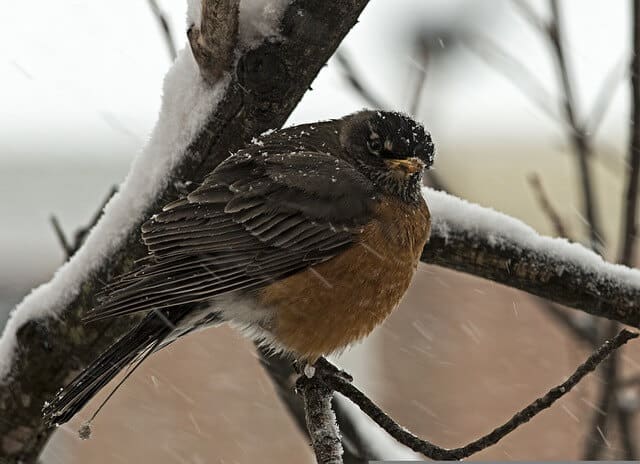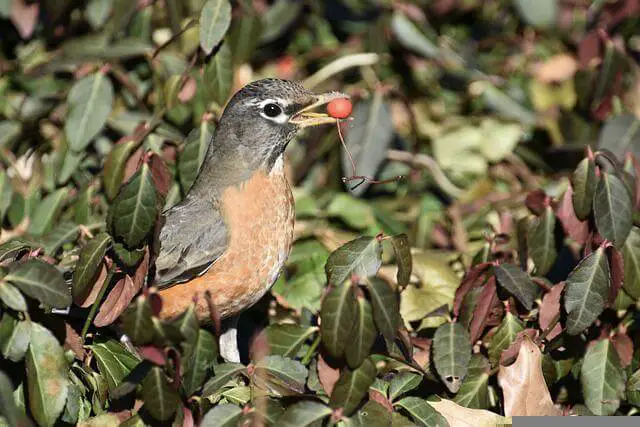The beautiful American Robin is often considered a harbinger of spring. But where do Robins go in the winter?
Some Robins will stay while others will definitely head south – it really depends on where they are residing and the overall food supply. Typically, Robins found South of Canada will stick around, while the Robins further north head to places like Texas, Florida, Mexico, and all along the Gulf Coast.
In this article, we’ll tackle this subject in a little more detail, going into the habits of Robins where there is a chill in the air.
We’ll give you a hint before we get started – it has to get VERY cold before Robins decide to winter in the South.
Let’s talk about Robins and their wintering tendencies!
Where Do Canadian Robins Go For The Winter?
Robins have superior heat-regulation skills that make these birds quite adept at resisting the cold, even in places like Canada, where the winter tends to work overtime. In temperatures down to as little as -30 degrees Fahrenheit, Robins remain a toasty 104 degrees underneath those pretty feathers.

Unfortunately, In November and December, Canada can get to as low as -40, so Robins here tend to group together in large flocks, with a destination that often is defined as ‘anywhere south of Canada.’
This can take them to the Southwest United States, and in Texas and Florida, many a Robin will be found, and some will even go as far as the Gulf Coast or to Mexico until it gets a little warmer and they make their trip back.
Even though most of them will go, there will be some stragglers who will move to a lower elevation, or if their current locale is abundant with food, they might even stick around, but with the robust Canadian winters, these tougher-than-average Robins are definitely in the minority.
Do Robins Leave New England In The Winter?
As with Canada, New England Robins tend to head south as well, although the winters are a little milder in comparison with temperatures averaging between 32 degrees to as low as -20 degrees Fahrenheit.

That temperature variance makes a lot of difference, tempting more Robins to stick around than in their Canadian cousin’s colder climes, and during this time, they’ll make a feast of favorite foods such as juniper berries, crabapples, red cedar, and chokecherries – with the occasional shore-raid option of mollusks, to boot!
As the temperature variance makes their option to stay more feasible, New England Robins are considerably robust in the face of cold temperatures, but this doesn’t necessarily mean that they are tougher than the Canadian ones.
After all, at -30, they are okay, but Canadian Robins risk temperatures as low as -40 on occasions, so they’re probably just leaving more than their New England cousins to be on the safe side!
So, Not All Robins Migrate When Winter Is Coming?
Nope, not at all. American Robins that aren’t hanging their hats in Canada or New England tend to stay put wherever they happen to be living in the United States, though there are certainly exceptions. For instance, in Alaska, many Robins will consider spending their winter a little further south, and we can’t fault them for that.
On the flip side, while American Robins throughout the continental United States are largely found year-round, some of them really seem to like the cold and will choose to spend their summers in Alaska!

It’s also interesting to note that when Robins do leave to go south, it’s not as much of a ‘migration’ as it is a matter of ‘following the food.’ As they can resist temperatures that would fast-freeze other birds on tree limbs, the Robin can basically go where they want.
So rather than think of them as migratory birds, it’s really more accurate to label them as ‘nomadic’ ones, moving around to areas where there are sufficient food sources to sustain their flocks – which can number as little as 50 in northern climes and as many as THOUSANDS in the southern ones.
Do Robins Come Back To The Same Place Every Year?
Yes, Robins do have favorite spots to visit, and when you consider that they can have up to 3 broods per year and build a different nest for each, it’s notable that they often do select the same areas and even trees when it’s time to mate and raise some chicks or to get some much-needed rest time.

Robins typically spend around 5 weeks in their nest from the moment they built the nest and till the young develop their wing feathers ready for flight.
That said, as far as traveling back and forth and spending time in their same favorite spots, the Robin is definitely ‘guilty as charged,’ often coming back to the same favorite places year after year as time goes by.
Learn More: Do Robins Reuse Their Nests?
What Should I Feed To Robins Wintering In My Area?
During the winter, if you want to prepare your feeder to host some Robins that have been visiting every year, then you want to focus on nice, high-energy foods. If the temperature allows, mealworms are always welcome, although if it gets cold enough, then they do tend to die.
As an alternative, you can feed them fresh or even frozen fruits, and peanut butter is also a popular treat for a wintering Robin to help keep them healthy and warm.
Still Curious? Read More: What Do Robins Eat When There Is Snow On The Ground?

Why Do Wintering Robins Ignore My Hanging Feeder?
Speaking of feeders, if you are trying to attract some wintering Robins that are nearby, but don’t seem to be tempted by your hanging feeders, then don’t worry – they need a place to perch.
Robins like to eat perched and will often avoid hanging feeders, so either a new feeder or even a cheap table is all that you need to make your feeder-feast a little more Robin-friendly.
If the local Robins have been ignoring your hanging feeders, then you’ll definitely want to give this a try – it makes a big difference, and the Robins will be very happy with your thoughtful gesture of welcome.
Some Final Words On Robins And Winter Migration
So we’ve addressed the question where do Robins go for winter and the answer basically boils down to ‘south – or wherever the food is’. Robins aren’t just good-looking birds but rather are gifted by Nature with the ability to withstand temperatures as low as -30 degrees, all while staying a comfy 104 below their feathers.
While Canadian and New England Robins tend to winter in the South, even there, some will stick around, and American Robins in North America will also tend to stay put, though they might just summer in Alaska.
As they tend to choose favorite places, if you notice Robins nearby around the same time every year, then you should definitely consider leaving a little something out for them – just make sure they have somewhere to perch that has a good view for any potential predators.
If you manage to tempt one or more of these little nomads into becoming a regular winter visitor, then congratulations!


